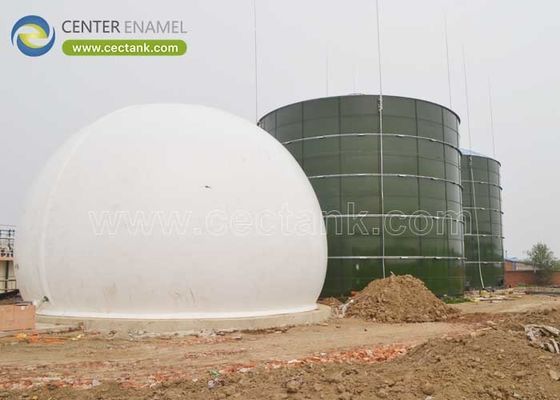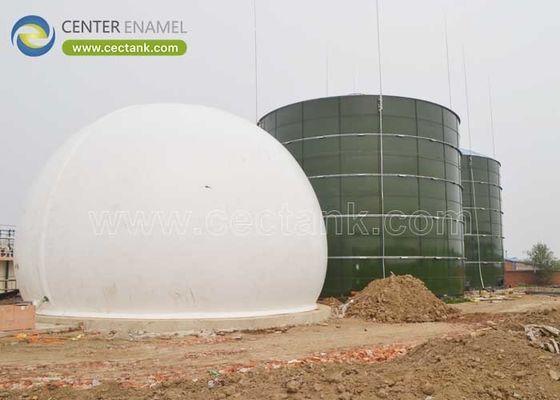-
Glass Fused To Steel Tanks (339)
-
Stainless Steel Tanks (365)
-
Fusion Bonded Epoxy Tanks (229)
-
Galvanized Steel Tanks (234)
-
Aluminum Dome Roofs (665)
-
Wastewater Storage Tanks (226)
-
Welded Steel Tanks (116)
-
Pressure Vessels (273)
-
Anaerobic Digester (201)
-
Industrial Water Tanks (349)
-
Glass Lined Steel Tanks (180)
-
Bolted Steel Tanks (181)
-
Sludge Storage Tank (115)
-
Biogas Storage Tank (173)
-
Leachate Storage Tanks (133)
-
Agricultural Water Storage Tanks (179)
-
Fire Water Tank (166)
-
Grain Storage Silos (130)
-
Biogas Projects (349)
-
Wastewater Treatment Projects (270)
-
Double Membrane Roof (88)
What is an Anaerobic Digester Tank?
| Place of Origin: | China |
| Brand Name: | CEC TANKS |
| Certification: | ISO 9001:2008, AWWA D103 , OSHA , BSCI |
| Model Number: | W |
| Minimum Order Quantity: | 1set |
| Price: | $5000~$20000 one set |
| Packaging Details: | PE poly-foam between each two steel plates ; wooden pallet and wooden box |
| Delivery Time: | 10-30 days after deposit received |
| Payment Terms: | L/C, T/T |
| Supply Ability: | 60 sets per month |
|
Detail Information |
|||
Product Description
What is an Anaerobic Digester Tank?
In the modern era, where sustainability and renewable energy are at the forefront of global priorities, anaerobic digestion has emerged as one of the most effective processes for managing organic waste. At the heart of this technology is the Anaerobic Digester Tank, a crucial component in the conversion of organic materials into biogas, a renewable energy source. As a global leader in storage tanks manufacturing, Shijiazhuang Zhengzhong Technology Co., Ltd. (Center Enamel) is proud to provide cutting-edge Anaerobic Digester Tanks, designed to optimize the waste-to-energy process for industries worldwide.
What is an Anaerobic Digester Tank?
An Anaerobic Digester Tank is a sealed vessel where organic waste is broken down by microorganisms in the absence of oxygen. The process is known as anaerobic digestion. During this biological process, organic materials such as food waste, manure, sewage sludge, agricultural residues, and industrial effluents are decomposed by bacteria and other microorganisms.
The result of anaerobic digestion is the production of biogas, which consists primarily of methane (CH₄). Methane is a clean, renewable energy source that can be used for electricity generation, heating, and even as vehicle fuel when upgraded to biomethane. The by-product of anaerobic digestion, known as digestate, is a nutrient-rich substance that can be used as a natural fertilizer in agriculture, contributing to a more sustainable and circular economy.
As a leading storage tank manufacturer worldwide. Center Enamel can provide Glass-Fused-to-Steel (GFS) tanks, fusion bonded epoxy tanks, stainless steel tanks, galvanized steel tanks and aluminum geodesic dome roofs, Wastewater and Biogas Project Equipments for global customers.
| Configuration of Customized Storage Tanks | ||||
| Storage tanks | Volume | Roofs | Application | Design Requirements |
|
GFS Tanks SS Tanks Fusion Bonded Epoxy Tanks Galvanized Steel Tanks Welded Steel Tanks |
<1000m³ 1000-10000m³ 10000-20000m³ 20000-25000m³ >25000m³ |
ADR Roof GFS Roof Membrane Roof FRP Roof Trough Deck Roof |
Wastewater Treatment Project Drinking Water Project Municipal Sewage Project Biogas Project Fire Water Storage Project Oil Storage Project |
Water Supply & Drainage System Seismic Design Wind Resistant Design Lightning Protection Design Tank Insulation Design |
WasteWater Treatment Project Equipment Supply
| Pretreatment Equipment | Resource Utilization System | Sludge Treatment System | Other Equipment |
|
Mechanical Bar Screen Solid-liquid Separator Submersible Mixer |
Gas Holder Boiler System Boost Fan Biogas Generator Torch System Dehydration and Desulfurization Tank |
PAM Integration Dosing Device Screw Sludge Dewatering Machine Slurry Separation Centrifuge |
Sewage Pump Mud Scraper Submersible Sewage Pump Three-phases Separator |
How Does an Anaerobic Digester Tank Work?
The working principle of an Anaerobic Digester Tank revolves around creating a controlled, oxygen-free environment for microorganisms to break down organic waste. The tank is typically equipped with several key components:
Inlet System – This is where the organic waste is fed into the tank. Waste materials are often pre-treated to ensure optimal conditions for digestion.
Digestion Chamber – The main part of the digester tank where anaerobic digestion takes place. The tank is sealed to prevent oxygen from entering and allow the bacteria to break down the organic material into biogas and digestate.
Gas Holder – This component captures the biogas produced during digestion. The gas can be stored and used as an energy source, either on-site or transported to external facilities.
Outlet System – Once the organic matter has been fully digested, the remaining digestate (a slurry-like material) is removed through the outlet system. This digestate can be used as fertilizer or further processed for other uses.
Mixing System – Some anaerobic digesters are equipped with mixing systems to ensure that the organic waste is evenly distributed throughout the tank and to improve the efficiency of the digestion process.
Key Benefits of Anaerobic Digester Tanks
Anaerobic Digester Tanks offer a range of advantages, especially when compared to traditional waste management methods:
1. Renewable Energy Production
The biogas produced from anaerobic digestion is a clean and renewable energy source. It can be used to generate electricity and heat, or it can be upgraded to biomethane, which can be used as a substitute for natural gas. This helps reduce reliance on fossil fuels and contributes to carbon footprint reduction.
2. Waste-to-Energy Conversion
Anaerobic digestion allows for the conversion of organic waste into valuable energy, providing a sustainable waste management solution. This is particularly beneficial in industries that generate large amounts of organic waste, such as agriculture, food processing, and municipal waste management.
3. Reduced Greenhouse Gas Emissions
By capturing methane, anaerobic digestion prevents the harmful release of greenhouse gases into the atmosphere. Methane is a potent greenhouse gas, but when captured and utilized for energy production, it has a much lower environmental impact compared to traditional waste disposal methods like landfilling or incineration.
4. Nutrient-Rich Fertilizer
The by-product of anaerobic digestion, the digestate, is a rich source of nutrients like nitrogen, phosphorus, and potassium, making it an ideal organic fertilizer. This reduces the need for chemical fertilizers, contributing to sustainable agricultural practices and closing the loop in waste management.
5. Cost Savings
By generating energy from organic waste, businesses can reduce their energy costs. The energy produced can be used for on-site operations, or excess biogas can be sold back to the grid. Additionally, waste disposal costs are minimized as organic waste is diverted from landfills and incineration.
6. Scalable and Flexible Solution
Anaerobic Digester Tanks are highly scalable and can be customized to suit the needs of different industries, from small-scale farms to large industrial operations. This flexibility makes them suitable for a wide range of applications, from treating food waste to managing sewage sludge and agricultural by-products.
Applications of Anaerobic Digester Tanks
Anaerobic Digester Tanks have broad applications across various industries, each benefiting from the conversion of organic waste into renewable energy. Here are some of the key sectors where these tanks are used:
Agriculture – Treatment of animal manure, crop residues, and other organic agricultural waste to produce biogas for energy generation and digestate for use as fertilizer.
Food and Beverage Industry – Food processing plants produce large amounts of organic waste that can be treated in anaerobic digester tanks to generate biogas and reduce waste.
Municipal Wastewater Treatment – Anaerobic digestion is used to treat sewage sludge, converting it into biogas and reducing the volume of waste that needs to be disposed of.
Landfill Gas Recovery – Anaerobic digestion is used to capture and recover methane gas from landfills, providing a sustainable energy source while reducing greenhouse gas emissions.
Industrial Waste Treatment – Industries such as paper mills, pharmaceuticals, and breweries generate large quantities of organic waste that can be treated to produce renewable energy.
Why Choose Center Enamel's Anaerobic Digester Tanks?
At Shijiazhuang Zhengzhong Technology Co., Ltd. (Center Enamel), we specialize in designing and manufacturing high-quality Anaerobic Digester Tanks for a wide range of applications. Our tanks are made from high-strength bolted steel coated with glass-fused-to-steel (GFS) or fusion-bonded epoxy (FBE) coatings, ensuring durability and resistance to corrosion. Here are some reasons why our Anaerobic Digester Tanks stand out:
Durability and Longevity: Our bolted steel design provides exceptional resistance to wear, corrosion, and extreme weather conditions, ensuring a long lifespan.
Customization and Scalability: We offer tailored solutions to meet the specific needs of different industries, with flexible tank sizes and designs.
Efficiency and Reliability: Our anaerobic digester tanks are designed to maximize biogas production while maintaining high operational efficiency.
Sustainable Solutions: We provide eco-friendly systems that help businesses reduce waste, lower energy costs, and contribute to a circular economy.
Anaerobic Digester Tanks play a crucial role in the sustainable management of organic waste and the production of renewable energy. As industries worldwide look for innovative solutions to address waste disposal, reduce energy costs, and minimize their environmental impact, anaerobic digestion offers an effective pathway forward.
Center Enamel is committed to providing high-performance anaerobic digester tanks that help our clients unlock the potential of organic waste while supporting their sustainability goals. If you are looking to adopt waste-to-energy technology, contact us today to learn more about our customized Anaerobic Digester Tanks and how we can support your renewable energy journey.




